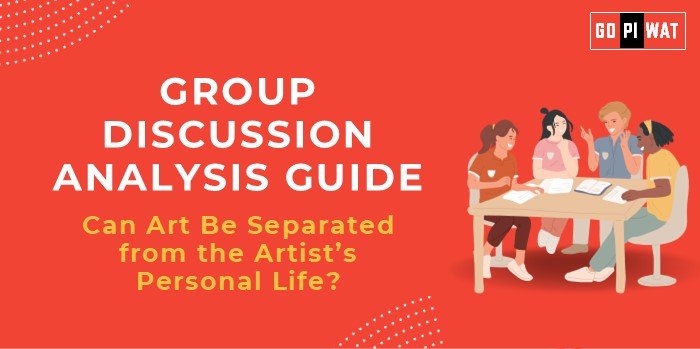📋 Group Discussion (GD) Analysis Guide: Can Art Be Separated from the Artist’s Personal Life?
🌐 Introduction to the Topic
- 📜 Opening Context: The debate on whether art can be appreciated independently of the artist’s personal life has gained traction with modern controversies, especially involving prominent figures in literature, cinema, and visual arts.
- 📖 Topic Background: This philosophical question intersects ethics, aesthetics, and societal values. With the rise of cancel culture and scrutiny of artists’ behavior, the discussion challenges our perception of art as a standalone entity versus a product intertwined with its creator’s identity.
📊 Quick Facts and Key Statistics
- 🎨 Global Art Market: Valued at over $67.8 billion in 2023, illustrating art’s cultural and economic impact.
- 📊 Cancel Culture Impact: 58% of Americans believe separating art from the artist is essential (Pew Research, 2022).
- 🎥 Case Example: Woody Allen’s films see reduced box office revenue post-controversy, reflecting changing audience attitudes.
👥 Stakeholders and Their Roles
- 🎨 Artists: Creators whose personal lives often influence or overshadow their work.
- 👥 Consumers: Audiences whose interpretations vary based on knowledge of the artist’s life.
- 🏛️ Institutions: Museums, studios, or galleries that must balance showcasing art and societal ethics.
- 🖋️ Critics: Mediators analyzing art through lenses of both aesthetic value and moral implications.
🏆 Achievements and Challenges
✨ Achievements
- 🌍 Transcending Individual Flaws: Art remains a medium transcending individual flaws, as seen with historically problematic yet celebrated figures like Picasso.
- 📜 Legal Separations: Contracts for intellectual property allow art to thrive independently.
⚠️ Challenges
- ⚖️ Societal Pressures: Increasing demand for moral accountability influences how art is consumed and valued.
- 🌀 Ethical Dilemmas: Arise when the artist’s actions directly contradict societal values.
Global Comparisons:
• USA: Discussions around cancel culture deeply influence artist reception.
• Europe: More leniency in separating classical artists’ personal lives from their work.
Case Studies:
• Michael Jackson’s Music: Despite allegations, his influence persists.
• J.K. Rowling: Harry Potter’s cultural impact endures despite the author’s controversial remarks.
📢 Structured Arguments for Discussion
- 💬 Supporting Stance: “Art is an independent expression, with its value derived from interpretation, not the artist’s morality.”
- 🗣️ Opposing Stance: “Artists influence their work profoundly; ignoring their personal life risks normalizing harmful behavior.”
- ⚖️ Balanced Perspective: “While art can stand alone, understanding the artist’s context adds depth to its interpretation.”
📈 Effective Discussion Approaches
- 💡 Opening Approaches:
- “Should personal ethics determine artistic merit?”
- “Can art transcend the controversies surrounding its creator?”
- 💡 Counter-Argument Handling:
- Use real-world cases, e.g., discussions on cancel culture’s selective application or legal separations in intellectual property rights.
📊 Strategic Analysis of Strengths and Weaknesses
Strengths
- 🌍 Art’s universal and timeless nature.
- 📜 Cultural preservation despite controversy.
Weaknesses
- ⚖️ Ethical dilemmas in supporting controversial figures.
Opportunities
- 📚 Education on contextualizing art.
Threats
- 🌀 Polarized consumer opinions affecting art’s legacy.
🎓 Connecting with B-School Applications
- 💡 Real-World Applications:
- Ethics in leadership parallels separating personal values from professional decisions.
- 💡 Sample Interview Questions:
- “Should organizations separate leaders’ performance from their personal ethics?”
- “How does cancel culture impact branding?”
- 💡 Insights for B-School Students:
- Ethics play a crucial role in decision-making; this topic fosters critical thinking and balanced perspectives.


